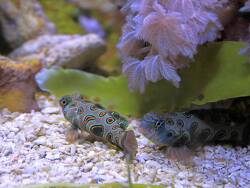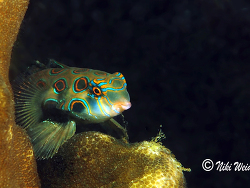Info
Synchiropus picturatus, Peters, 1877
The lyrefish family (Callionymidae) is a group of perch relatives (Percomorphaceae). Many lyrefish are very colorful and are therefore popular to keep in aquariums. However, lyrefishes are not so easy to keep because of their food requirements, as they have to eat constantly . Synchiropus picturatus can therefore be kept mainly in well acclimated tanks with several months standing time and correspondingly distinctive microfauna, because it feeds on micro animals, which are found in the substrate and on the stones.
Sometimes a change to frozen food works, sometimes not. It has to be said that the Synchiropus picturatus accepts food in the aquarium a bit earlier than the also very popular Synchiropus splendidus.
The tank should also offer good hiding places. Under no circumstances should two males be placed in the same tank, as they would fight each other to the death. The males can be recognized by the extended dorsal fin spine.
Keeping them in pairs is no problem and even advisable if the tank is big enough. There is nothing more beautiful than the spawning behavior of lyrefish.
One should not socialize Synchiropus splendidus and Synchiropus picturatus - this usually goes wrong!
The LSD fish - Synchiropus splendidus asserts itself, in our experience, and will not leave the other "Blue" Mandarin fish - Synchiropus picturatus alone!
The LSD fish - Synchiropus splendidus asserts itself, in our experience, and will not leave the other "Blue" Mandarin fish - Synchiropus picturatus alone!
Synonyms:
Callionymus picturatus Peters, 1877
Pterosynchiropus picturatus (Peters, 1877)
Classification: Biota > Animalia (Kingdom) > Chordata (Phylum) > Vertebrata (Subphylum) > Gnathostomata (Superclass) > Pisces (Superclass) > Actinopterygii (Class) > Perciformes (Order) > Callionymidae (Family) > Synchiropus (Genus) > Synchiropus picturatus (Species)
Feeding intake.
The fish take a long time to eat at the beginning, before the food is taken up, a close inspection is carried out. After acclimatisation, the offered frozen food is eaten without problems. It should be noted that wild-caught fish behave differently than offspring when it comes to food intake. In the case of offspring, the size of the fish purchased also plays a role in the choice of food.
am 11.12.23#18
Den schönen LSD Leierfisch halte ich seit mehreren Jahren. Das Tier hat relativ schnell Frostfutter angenommen, kann sich aber selbst in einem kleinen Becken, bei mir 180 Liter, zumindest einige Wochen von der Mikrofauna ernähren. Ich habe einige Zeit nur Flocken gefüttert, die er nicht frisst, und er hat nicht sichtbar abgenommen. Allerdings steht das Becken auch schon seit über 8 Jahren.
Vor drei Jahren habe ich mal versucht, ein Weibchen zuzusetzen. Offenbar handelte es sich aber doch um ein Männchen. Das Tier musste ich schnell wieder entfernen und abgeben, da mein Fisch ihn sonst getötet hätte.
Der Fisch hat auch Phasen, in denen ich dem Becken wenig Aufmerksamkeit geschenkt habe, nie Probleme gehabt. Ich halte den LSD-Leierfisch für sehr widerstandsfähig und kann ihn sehr empfehlen.
am 16.11.19#19
Wir haben ein LSD Leierfisch geholt weil wir starken Planarienbefall an einer Goniopara hatten. Hat super geholfen , das Weibchen ist stark gewachsen und kugelrund und die Gonio ist schön expandiert. Als wir dem Weibchen ein deutlich kleineres Männchen dazugesetzt hatten hat es leider das Männchen stark attackiert und das Männchen war am nächsten Morgen nicht mehr aufzufinden
am 25.11.18#18
Im Februar 2018 habe ich ein Männchen gekauft. Mein Becken stand schon 4 Jahre. Wollte eigentlich ein Pärchen haben aber es gab nur den einen. Er hat sich schnell eingelebt und ging auch an Frostfutter, da er aus einer Beckenauflösung stammt. Die Suche nach einem Weibchen war sehr schwierig. Aber wie der Zufall es so wollte habe ich im selben Geschäft im März ein Weibchen bekommen. Das Weibchen geht bis heute nicht an Frostfutter und er frist mir aus der Pipette. Sie war deutlich kleiner und er musste ihr für ca. eine halbe Stunde zeigen wer der Chef im Becken ist. Aber alles ging gut. Abends in der Mondlichtphase tanzten sie immer zur Wasseroberfläche. Ich konnte beobachten das sie immer runder wurde. Habe mir versucht eine eigene (Parvocalanus crassirostris Zucht) aufzubauen, was aber der schwierigste Teil der Sache war. Eines Abend tanzten sie wieder zur Oberfläche und es Plätscherte...die Eier waren abgeleicht. Ich sammelte die Eier ab und versuchte mich an der Aufzucht. Leider hab ich nur 6 Tage geschafft. Das Schwierigste an dem ganzen Prozedere ist es das Futter für die Larven zu Züchten. Vieleicht werde ich es irgendwann noch mal Probieren, denn es sind Tolle Tiere. Ich würde auch sagen das es auf Grund des Fressverhaltens kein Anfängertier ist.







 NikiWei
NikiWei


































